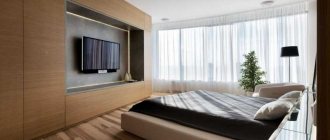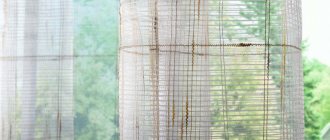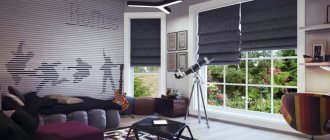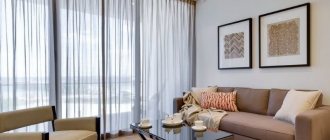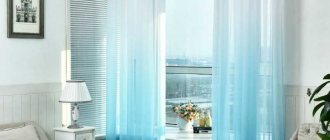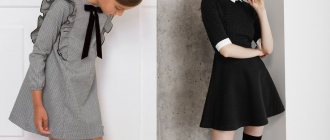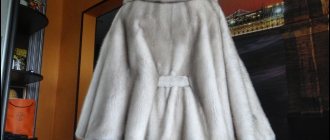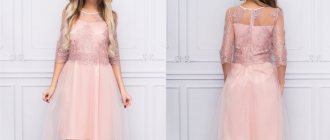Tulle curtains in combination with thicker curtains give the window a complete look, soften the light coming from the street and bring additional coziness to the decor of the room. Despite the fact that today there are many other options for decorating window openings, there are a number of trends in interior design that are difficult to imagine without these airy curtains. These, for example, include Baroque, classic, modern or Provence.
And many people wonder how to beautifully hang tulle in order to emphasize all the advantages in the design of the room? First of all, you should decide on the type of tulle curtains.
Functions of modern tulle
The time for beautiful dust collectors on windows is over. Modern beautiful tulle should not only be beautiful, but also fulfill the tasks assigned to it:
- Cover windows from prying eyes from the street;
- Diffuse too bright sunlight during the day;
- Visually expand the room and make it brighter;
- Cover unsightly risers and radiators under windows or balcony doors.
Designers are now increasingly advising against multi-layered sets consisting of tulle and curtains, and are advised to opt for just one thing.
If you need to shade a room during the day, replace classic long curtains with roller curtains, and give the decorative role to modern tulle.
Combination with other types of curtains
Tulle can be used as an independent decorative element, or can be combined with another type of curtains for greater darkness.
Curtain and tulle
Curtains and tulle are often found on the same cornice in any interior style. They can be plain or multi-colored. With this combination, the pattern should be on only one item, or the pattern should match. There is no need to combine curtains made of natural fabric, such as linen, and organza tulle.
Roller blind and tulle
They are combined if the tulle is transparent or covers half of the window, and its length does not matter. When rolled up, the roll will not be visible.
Roman blind and tulle
Roman blinds and tulle are suitable for a modern living room, nursery or bedroom. It is better to mount it on the sash or in the opening. The color of Roman blinds can be the same or contrasting.
The photo on the right is an example of how the interior looks harmonious when the curtain pattern is selected to match the pattern on the wallpaper. Transparent tulle frames the window with light drapery.
Thread curtain and tulle
Thread curtains and tulle can be combined, provided there is a combination of different colors, while the thread curtains should be thick, and the tulle should be openwork or translucent.
Fashion trends
2021 has seen many new designs in tulle designs. Here are just a few of them:
- A combination of different shades of the same color in one canvas;
- Lace elements combined with smooth fabric;
- Smooth color transitions in amber style;
- The most simple cut without lambrequins, turns and ruffles;
- Striped print;
- Combination of matte and glossy texture;
- Natural shades.
Design tips
When choosing tulle, you should rely on the following criteria:
- In a room without a specific style, curtains in pastel colors are optimal.
- It is better to highlight an elaborate interior with tulle in light colors.
- Plain curtains go well with patterned wallpaper.
- Tulle in subdued colors will not distract attention from the decorative elements in the living room.
- When choosing the type of fastening, you should focus on the geometry of the room.
Let's summarize: The guest's impression of visiting the house is largely determined by the living room. And a competent approach to window design will not go unnoticed.
When choosing the material, color and length of tulle, you should take into account the size of the window opening and the room. Then the curtain will not only decorate the room, but also disguise any imperfections, including low ceilings or narrow windows.
In cramped living rooms, preference is often given to simple curtains in a minimalist style. Spacious rooms open up more design possibilities, taking into account the selected furniture and wallpaper on the walls.
Net
Mesh curtains come in completely different varieties. If for the last few years coarse cotton mesh has been used, then in recent photos of new tulle products you can see the finest mesh, which forms an almost smooth fabric. It is made from cotton threads.
This curtain allows air to pass through well. In addition, you don’t need to iron it, just wring it out and hang it by the window, it will straighten up perfectly under its own weight.
Style decision
Universal window decor allows you to highlight any interior style.
Modern style
For a modern interior, a plain tulle, striped, with a little embroidery is suitable. The color does not matter, but it should be appropriate in the decor. Simple lines, clear fabric without asymmetry are welcome in a modern style.
Classic style
The classic interior lies in the consistency and combination of heavy brocade or velvet curtains with light patterned muslin in beige or white, as well as a soft lambrequin or sash with fringe and tassels. When sewing, it is important to take into account that the tulle does not reach the floor by 2 cm, and the curtains lightly touch it.
The photo shows a classic interior, where the curtains are attached to a closed baguette. Fastening with braid ensures frequent drape of the fabric.
Provence
For Provence, a light texture of fabric is suitable, which can be easily draped in lush folds on the sides of the window. Mesh, tulle with embroidery, and a floral pattern are suitable. The length can be any, depending on the interior and size of the room.
Scandinavian style
The Scandinavian interior does not imply the use of heavy curtains, so white muslin without openwork and a simple cut is suitable here. It can also be combined with a roller blind.
Photo of tulle
Tulle in bunches
For large rooms with wide windows, curtains are often collected in bunches. They allow light to better penetrate the room. To do this, you will need a cornice with two channels for curtains. Here it is better to use options that differ slightly in shades: pink and cream; white with coffee. We hang two tulles on each of the cornice strips. Then we create volume in the upper part, and collect the lower part into bunches. For decoration, you can use ribbons or nylon laces with pompoms.
Snow-white curtain for the hall Source cmp24.ru
On a note! Often tulle is not used on its own. It plays the role of a background for the night thick textured curtains.
Legend of the Veil
The first translucent curtains were made from veils. Initially, this was not the name of an item of clothing for the bride, but a thin fabric that was used to cover the girls’ heads. According to legend, when one of the French kings was getting married, the bride asked him to order a fabric through which she could see everything, and her face would be hidden from onlookers.
The girl was very shy and did not want ordinary people to look at her like an animal in a circus. The groom fulfilled her request, and after a while the fabric began to be used so that passers-by would not look into the windows, and light would freely penetrate into the house.
The French liked the new-fashioned decoration so much that curtains made of fine fabric began to be hung on windows everywhere. Later, other types of curtain material appeared, but they were all translucent and very light.
Austrian design
This type of curtains can be made either from thick curtain material or from tulle or curtain fabric. They look like a straight piece of fabric that is divided vertically into three parts by two pieces of ribbon or decorative cord. When the cords are tightened, you get a semicircular cut in the middle and two pleated beautiful edges of the curtain.
Austrian curtains look lush and elegant, and thin translucent fabric will give them lightness and modernity. Austrian curtains can be made either short, just below the window sill, or almost to the floor.
Tulle materials
There are 3 main materials from which window tulle is made:
- Organza is a rigid fabric made of polyester, silk or viscose. Transmits light, repels dust, but traps air.
- Veil - made from synthetic or cotton fibers, silk. The fabric is soft and drapes well. The veil is less transparent than organza. A very thin veil is called a microveil.
- The mesh allows air and light to pass through, but collects dust.
When hanging tulle on windows, you need to take into account the need to fill the room with light and air, as well as a possible reaction to dust if you choose a mesh.
Designers recommend choosing organza to create frozen images. Lush drapery is made from a veil - this is how flying compositions are created.
Design features of small kitchens
When we are talking about decorating a window opening in a small room, you should still choose tulle in light shades; it will not attract unnecessary attention, and the translucent texture will allow you to visually increase the size of the room.
If the width of the window sill allows, you can convert it into a tabletop. This will help gain a few more centimeters of space, and you can hang a short Roman blind made of tulle on such a window.
Length selection
The length of the tulle can be different; for the hall you can purchase:
- short - length to the windowsill. Ideal for Provence, country, ecological, and cramped rooms. In spacious rooms this solution looks rather poor. This is the best option for horizontal windows located in a niche, especially if there are no heating radiators underneath them. In the latter case, the place below the window is decorated with patterns, bright photo wallpapers, pictures;
- ordinary (medium) – reaches the floor without touching it, used most often. The fabric should completely cover the battery, if there is one, and not be too short, “shot”. This decor is also suitable for panoramic windows;
- long - lies in folds on the floor. Suitable for apartments where there are no small children, elderly people, active pets who can get tangled in the curtain, get injured or tear it off. Such curtains look good in arches, add coziness to large rooms, and make small ones stylish.
For rooms with a balcony door, a combined option is allowed: a short tulle above the window itself, a separate long curtain above the exit to the balcony
Color
The color scheme directly depends on the interior style of the room. Almost any options are acceptable - monochrome, variegated, with gradient transitions. The color is matched to thick curtains, if present, carpets, other room textiles, and less often, tulle is a bright accent.
Popular options:
- snow-white;
- agate gray;
- saffron yellow;
- amethyst;
- fuchsia;
- turquoise;
- moderate pink;
- herbal;
- pale green;
- amber;
- lilac;
- bronze;
- yellow-orange;
- gray;
- pearl;
- light green;
- reddish beige.
With or without curtains
Most often, tulle is an addition to thick curtains, but not always - its multi-layer versions provide good protection from street light. A simple, lightweight option is used in loft interiors, where curtains will be “out of theme”; minimalistic, Japanese interiors also “will not tolerate” unnecessary ones.
Modern fashion provides tulle curtains of different densities, combining which with each other creates a unique, unique appearance.
When the pattern on thick curtains is very complex, there is colorful embroidery, a lot of printed prints, three-dimensional elements, then the tulle is purchased in a single color or with a paler, smaller pattern, partially or completely repeating the curtain one.
It is unacceptable to overload the window opening with unnecessary elements.
Curtains and drapes
How to hang tulle? The correct answer is no longer limited to one option. A fashionable interior is created in the following ways:
- Traditional - tulle is located closer to the window, curtains on the sides.
- Solo - only a transparent curtain is hung on the window, decorated with draperies, folds, coattails, and swags. When decorating, lambrequins, tiebacks, and hairpins are used.
- Modern - tulle is hung on top of heavy curtains. This combination muffles the sound of the curtains, and the curtains are saturated with their shade.
Solid color or pattern
White tulle is universal for any room, window, style. At the same time, modern design involves the use of colored, embroidered, patterned, guipure inserts or completely lace fabrics. Each of them has specific application:
- A plain curtain is hung in small rooms or selected for bright curtains
- Lace - suitable for classic, baroque, retro styles. It gives the environment a luxurious look
- Patterned curtains enliven a window with plain drapes - tulle takes on the main role
- Guipure inserts in the fabric maintain a balance between a festive curtain and a daily one - this design of tulle on the windows will always allow them to look solemn, but not tire you with luxury
With an image

